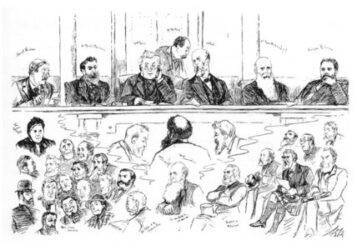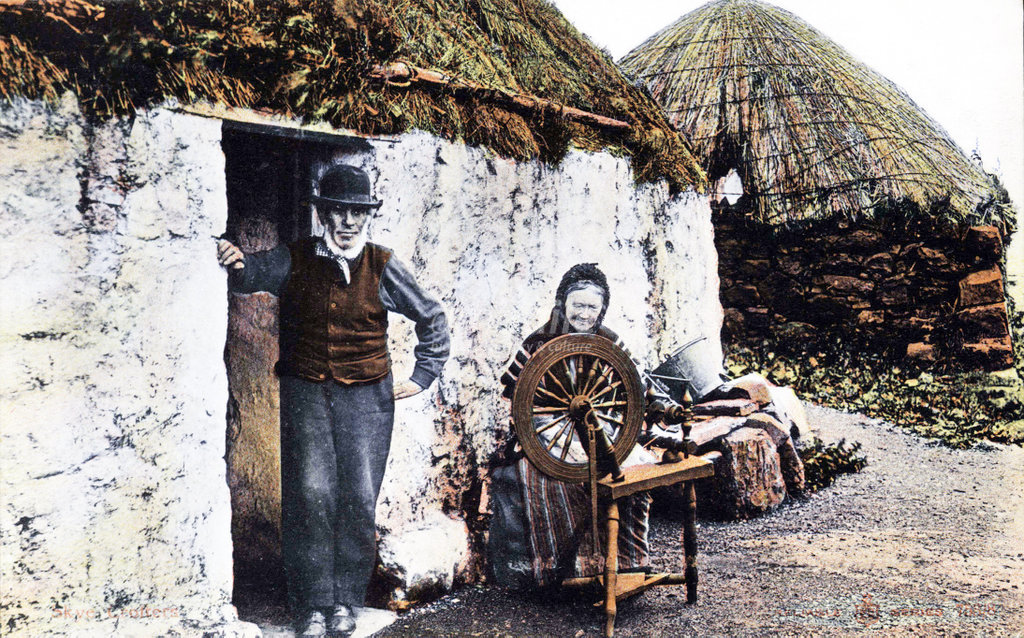The Royal Commission of Inquiry into the Condition of Crofters and Cottars in the Highlands and Islands, the Napier Commission for short, was a public inquiry set up in response to land agitation in the Highlands and Islands, including the Battle of the Braes, in the hope of quickly appeasing the situation.
On the 17th of March 1883 six men were appointed to the commission by the Home Secretary. Led by Lord Napier, all the men were part of the upper classes, including two who were landlords. Charles Fraser-MacKintosh, MP for Inverness burgh, had been campaigning for a royal commission on behalf of the crofters beforehand and was the only one who was sympathetic to the crofter’s cause.
On May 5th the commission began its tour of the highlands to gather evidence. The tour lasted 5 months, included 71 meetings in 61 locations across the Highlands. It heard from 800 people including crofters, factors, ministers and landowners. The first testimony was heard on the 8th of May 1883 from Angus Stewart, a crofter from Braes, Skye. He gave his testimony in Gaelic as many other crofters did. Within the interview he asked for reassurance that he wouldn’t be facing eviction for giving his testimony. Lord Napier offered no reassurance, telling him that the commission could not interfere, and that any incident would be between Angus and his landowner.
Angus’s account revealed the same problems that would be prevalently mentioned for the rest of the commission, namely that the crofters had been dealt with no security of tenure, overpriced rent and overcrowded close quarters. When asked how to solve these problems Angus summarised that to ‘give us land’ would be the only remedy. This answer would be heard many times.
This need for more land was well conveyed in this passage from the account of Glendale crofter and fisherman, Alexander Mackenzie:
‘’We are for ever sunk in debt, and have to spend the greater part of the year away from home to earn money to buy food for our families, and to pay the rent for the landlords; while want of success at the fishing, or other work we go to, for even one year, means either ruin or starvation. If we had properly sized crofts at a reasonable rent and fully stocked, this alternative would never arise.’’
When the Napier Commission report was finally released, no parties were content with it. The land owners and government considered it a disappointment.
From the crofters perspective the report did not tackle any of the root causes.
The report’s suggestions, mainly derived from Napier himself, were that those who made more than £6 annually received security of tenure through 30-year improving leases and township organisation, those who made under £6 a year were recommended to be emigrated.
However, the report did bring the crofting community together with the common interest of property rights, demonstrated by crofters collectively deciding on a common spokesperson. The report revealed the multitude of reasons why the crofters were so aggravated by their treatment to the point of disobedience towards authority. It also brought the crofters’ plight to wider society.
The Crofters Holding (Scotland) Act 1886
The recommendations from the Napier Commission, the growing public support the crofters gained from press coverage of their treatment, the liberal government of the 1880s lead by William Gladstone and the sheer determination of the crofters and the Highland Land League, together brought about the introduction of legislation that protected the rights of crofters, resulting in the Crofters Holdings (Scotland) Act 1886.
The Act applied to all crofters, regardless of their rent, and limited the powers of landlords to evict their tenants. It allowed crofters to nominate a successor in their family to inherit their croft, gave them the right to fair rents set by an impartial body, and ensured they were compensated for any improvements they made to the land if they were cleared from it. It also made some progress in securing rights to common grazing and the use of natural resources, like peat for the fire, seaweed for fertiliser, and heather for rope making. However, it did not address the overcrowding, which had resulted from the Clearances nor the needs of the landless cottar class.
“it did not give the crofters the world, but it made them secure in their own little patch, and that was no small gain.”
A. D. Cameron, Go Listen to the Crofters: The Napier Commission and Crofting a Century Ago (Stornoway: Acair Ltd., 1986): p126.
The Act paved the way for further land reforms in Scotland throughout the 19th and 20th centuries in the shape of several other pieces of legislation dealing with crofting and land rights. As well as having a long-term impact of legislative development in relation to land rights, the Battle of the Braes and the wider agitation in Skye had a lasting cultural legacy too.



